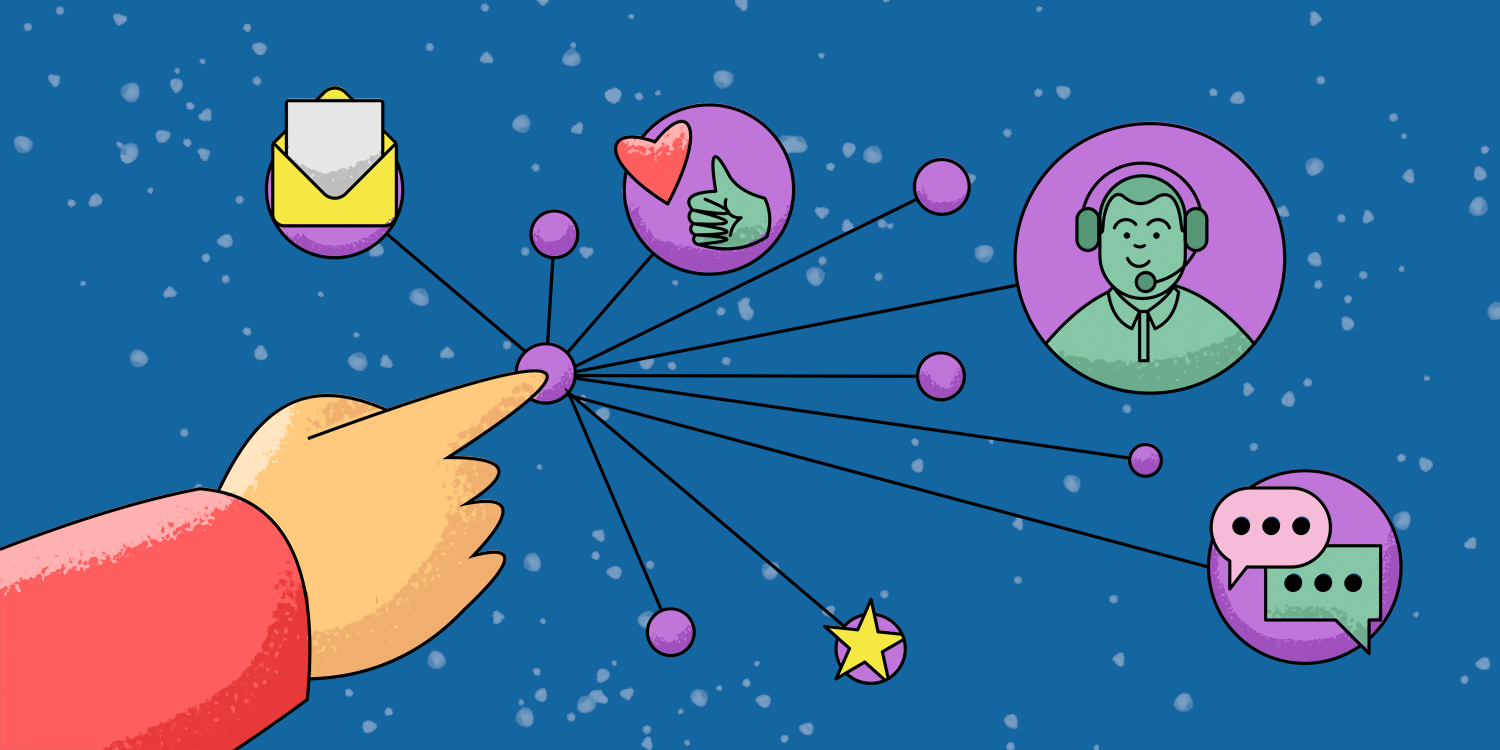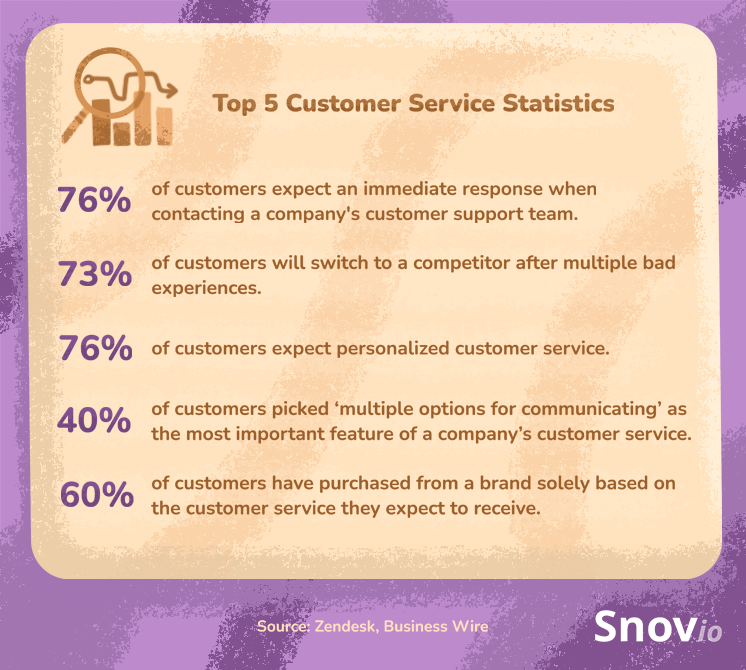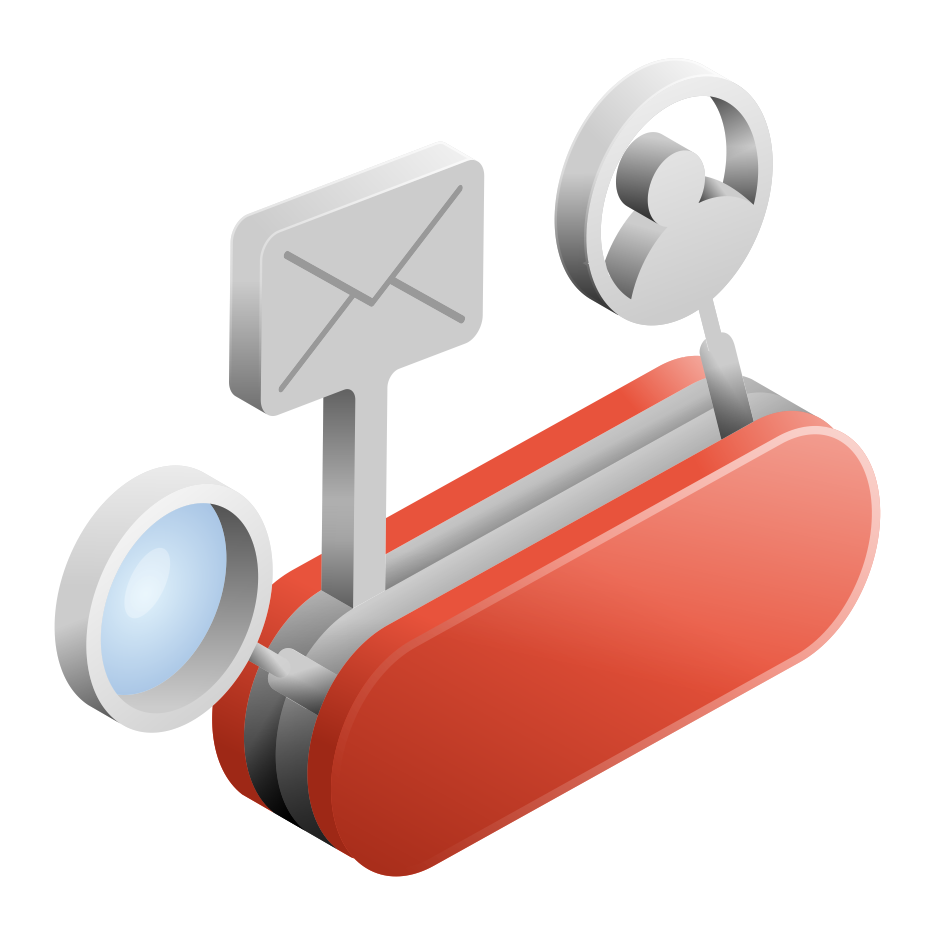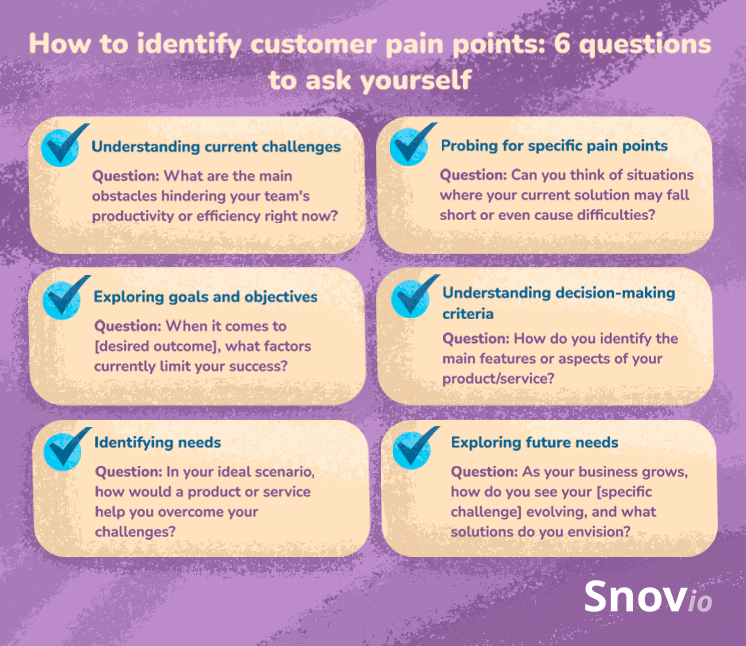Sales go beyond simply closing deals. They involve nurturing relationships, creating impact, and addressing customers’ challenges.
But how can you spot your customer’s pain points?
In this post, you’ll learn how to detect and tackle them effectively so that every deal you seal becomes a personalized assistance scenario! Let’s get started.
Outline:
What are the pain points?
Customer pain points are specific challenges or frustrations clients face when interacting with a business or using a product or service. These issues can span from dealing with a complex interface to a lack of features that cater to the customer’s specific needs and may differ depending on the industry, target audience, and context.
By effectively addressing customer pain points, you meet their needs and mitigate their dissatisfaction. This increases your chances of closing deals and helps you improve customer retention in the long run.
Why do you need to address the customer pain points?
Let’s start by discussing how addressing customer pain points can enhance your sales and marketing strategy.
Why you should address pain points
- Customer satisfaction and loyalty
- Competitive advantage
- Retention and repeat sales
- Word of mouth and referrals
- Product enhancement
- Brand reputation
- Cost efficiency
1. Customer satisfaction and loyalty
Addressing customer pain points directly can significantly impact their experience. By understanding and resolving their concerns, you can increase the likelihood of turning a one-time consumer into a loyal client.
|
💡 Food for thought About 83% of people demonstrate greater trust in businesses that address and solve their issues. And even with cheaper options, 56% of buyers are willing to spend more with a brand they favor. |
2. Competitive advantage
Addressing customer pain points and meeting their needs can give your business a competitive edge. By offering solutions that competitors may overlook, you can differentiate your brand and attract more potential customers.
|
💡 Food for thought 65% of customers expect companies to adapt to their changing needs and preferences. |
3. Retention and repeat sales
Satisfied clients are more likely to come back for more, while unhappy customers tend to look elsewhere. So it’s in your best interest to keep in touch with your clientele and promptly resolve any possible issues.
|
💡 Food for thought Email remains the most popular contact channel for support teams. This tool is essential for keeping prospects engaged and improving customer retention rates by sending timely follow-ups and personalized email sequences that adapt to their behavior.  With Snov.io’s Campaigns, you can create triggered, highly personalized, automated email sequences and ensure your sales team knows exactly when to solve customer pain points with AI-powered messages in hand. |
4. Word of mouth and referrals
Happy customers are your best promoters. By effectively addressing their specific pain points, you can spark positive recommendations and ultimately attract new potential customers to your business.
|
💡 Food for thought 94% of customers who rate a company’s service as “very good” are more likely to recommend that company to others. |
→ Learn how to ask for referrals from your customers in the most effective way.
5. Product enhancement
Identifying customer pain points within your product or service and subsequently addressing them yields valuable feedback for improvement.
|
💡 Food for thought Implementing your clients’ insights into your services or product leads to a 53% improvement in customer satisfaction, as it ensures that their needs are acknowledged and addressed. |
6. Brand reputation
Resolving customer pain points helps you improve your company image among your target audience. Plus, businesses that receive high reviews are more likely to expand their client base.
|
💡 Food for thought 95% of customers read online reviews before making a purchase. |
7. Cost-efficiency
More than two-thirds (70%) of managers agree that retaining customers is cheaper than acquiring new ones. By addressing common pain points through streamlined processes, tech integration, and constant quality enhancements, you can keep current customers in the funnel and save costs.
|
💡 Food for thought There are several ways to improve cost-efficiency and streamline customer service: |

Best Sales Email Templates For Your Next Great Deal
November 7 2025

20 Customer Touchpoints To Optimize Customer Experience
November 26 2025
Types of pain points
The same pain points can affect your clientele in different ways. However, categorizing them into broader groups can help you organize and better understand the end-to-end customer experience.
Examples of pain points
- Productivity & convenience pain points
- Financial pain points
- Customer journey pain points
- Product or service quality pain points
- Customer service pain points
1. Productivity & convenience pain points
These are the hurdles and challenges that customers face in their day-to-day operations. They frequently impede the efficiency, effectiveness, or overall productivity of the client’s business processes.
Examples
- Time-consuming processes: Customers may spend too much time on manual tasks that could be automated, which can lead to wasted time and resources.
- Complex technology: Mastering certain tools can be quite challenging, requiring extensive training that some people may find difficult to grasp.
- Insufficient analytics and reporting tools: Without proper data analysis, businesses make decisions in the dark, leading to poor strategic choices and missed opportunities.
- Lack of integrations: If a customer’s existing systems or tools do not sync seamlessly with each other, it can result in data silos and difficulties in maintaining a unified workflow.
2. Financial pain points
Essentially, it means that the customer is spending too much money on a particular service or product. These pain points often arise during the sales and revenue management process when prospects consider purchasing but encounter obstacles due to budget constraints, affordability concerns, or perceived financial risks.
Examples
- Pricing concerns: Unclear subscription plans, unexpected fees, or perceived high costs can deter customers from placing an order, especially if they feel that the value proposition isn’t aligned with the price.
- Budget constraints: Buyers may have limited funds and struggle to afford certain products.
- Uncertainty about ROI: Some prospects may hesitate to make a purchase if they are unsure about the return on investment (ROI) or long-term financial benefits.
- Affordability of upgrades or add-ons: Customers may be interested in a product’s additional features or upgrades but may feel they can’t afford them.
3. Customer journey pain points
These can arise at various stages of the buying process, from initial research and consideration to post-purchase service. These pain points reflect areas where customers’ experience does not meet their expectations, possibly due to unclear information, complex procedures, insufficient support, or other reasons.
Examples
- Lack of information: Customers may hesitate to complete a purchase because they can’t find relevant information about your company.
- Complex buying process: Insufficient processes can turn customers off, especially if there are too many steps or a lot of paperwork involved.
- Payment troubles: offering only a limited range of payment methods or failing to resolve technical issues with payment processing promptly can cause problems during the sales process and lead to missed opportunities.
- Lack of personalization: If customers don’t feel special during a sales process, they are less motivated to buy. By contrast, personalized interactions and tailored solutions show prospective buyers they’re valued and understood.
4. Product or service quality pain points
Any problems, concerns, or sources of dissatisfaction that customers encounter in different facets of product/service quality may hinder your business growth.
Examples
- Performance concerns: Slow processing speeds, poor efficiency, or inadequate results negatively affect how your clients perceive your product.
- Scalability limitations: Software that cannot handle increasing data loads or user traffic, businesses that can’t scale their services to support the client’s expanding needs—these issues may prompt your customers to turn to your competitors for better results.
- Functionality deficiencies: Products or services that lack features crucial for the client’s specific workflows can impede their ability to achieve desired outcomes. This can lead to workarounds, additional processes, and, ultimately, reduced productivity.
- Usability challenges: Products or services with intricate interfaces or poor design can discourage potential clients from using them.
5. Customer service pain points
These pain points are usually a result of poor support services.

Examples
- Ineffective communication: Not getting an answer, receiving unclear instructions, etc., can confuse people.
- No personalization: Prospects strongly dislike when customer support doesn’t understand and cater to their needs.
- Difficulty in accessing support channels: It can be annoying when there’s no online help or clear information on how to contact the customer service team.
- Inadequate problem resolution: Customers feel frustrated when their problems or queries aren’t properly addressed.

How To Improve Customer Experience With Email
September 2 2025
How to recognize customer pain points?
Now, let’s focus on how you can spot any issues your clients may encounter and find the perfect solution together.
How you can identify customer pain points:
- Create a buyer persona
- Listen actively
- Ask open-ended questions
- Initiate and analyze feedback
- Study competitors
- Utilize data analytics
- Master emotional intelligence
- Collaborate across departments
1. Create a buyer persona
Identifying your dream customer is akin to painting a vivid portrait. By delving deep into demographic information, goals, and needs, you can gain profound insights into the minds of your target audience and ‘predict’ possible issues.
2. Listen actively
Give full attention to your prospects, focusing on verbal and non-verbal cues to understand their needs and concerns. This means being present in the moment and showing genuine interest in what the customer is expressing.
3. Ask open-ended questions
Open-ended questions encourage clients to share detailed information and insights, providing valuable context for understanding their preferences.
|
💡 Pro-tip Save this check-list for identifying customer pain points:
|
4. Initiate and analyze feedback
Reviews obtained through surveys or direct communication can help reveal the level of satisfaction with a product or customer service. Initiate conversations, provide channels for customers to share their thoughts, and analyze this information regularly.
→ Read this easy guide on how to ask for reviews.
5. Study competitors
Research and evaluate products, services, and strategies of other businesses in your industry. You can identify customers’ needs and requests by understanding competitors’ strengths and weaknesses.
|
💡 Pro-tip Don’t miss a chance to research the market with Snov.io Technology checker. Find out what web technologies your rivals prefer. Use this information for your sales strategy and product improvement. |
6. Utilize data analytics
Leveraging data from various sources, such as sales transactions, website traffic, customer interactions, etc., can help you optimize your sales and marketing strategies.
7. Collaborate across departments
Work closely with colleagues from different teams – marketing, product development, and customer support. This way, you’ll be able to tackle each issue and ensure your clients feel supported.
How to tackle customer pain points: template for sales teams
This section provides an effective strategy for addressing customer pain points with examples. Feel free to use it as a template and tailor it to your unique goals.
How to address the pain points of your clients:
- Identify pain points
- Prioritize them
- Customize solutions
- Communicate value proposition
- Provide social proof
- Offer demos or trials
- Listen and adapt
- Follow up
- Provide ongoing support
1. Identify pain points
As we’ve already established, this is a crucial step. Listen to customers’ concerns and ask probing questions to delve deeper into the root causes of their issues. Conduct thorough industry research to gain a comprehensive understanding of their needs.
|
👉 Example: You work as a sales rep at a B2B product company that develops automation solutions for lead generation. You are on a call with your client, who shares their concerns about unsatisfactory lead management and missed follow-ups. You ask targeted questions and discuss their sales workflows, which eventually helps you identify the following pain points: manual data entry, limited visibility into sales activities, and insufficient tracking of customer interactions. |
2. Prioritize the issues
Not all pain points are equal! Focus on the most pressing ones by analyzing their impact on the customer’s business or personal objectives. Consider factors such as urgency, frequency, and severity.
|
👉 Example: You are a sales team lead at an IT support company. You’ve received feedback from your top clients regarding the quality of your services. They encounter several issues: software glitches, the inconvenient process of migrating to cloud-based solutions, and poor data security. Even though you have to figure out each problem, data security is the most important one in this situation, as keeping the information safe is always a top priority. |
3. Customize solutions
Tailor your solutions to address the problem directly. Avoid a one-size-fits-all approach. Instead, concentrate on each customer’s unique needs and preferences. Offer personalized recommendations that align with their specific challenges and goals.
|
👉 Example: You’ve detected that your prospect has trouble managing leads and boosting team productivity. So, you suggest a sales automation tool with lead scoring and activity tracking features. This solution simplifies lead qualification, automates tasks, and helps them gain insights into their performance. |
4. Communicate value proposition
In your sales pitch, clearly articulate how your product or service resolves the customer’s pain points. Highlight those tangible benefits and outcomes they can expect from implementing your solution. Use examples and data to illustrate the potential ROI and long-term value of your offering.
|
👉 Example: Your prospect works at a lead generation agency and is in search of an automation solution to help them save time and resources. During a sales presentation, you explain how your software will help the client’s team prioritize leads, personalize messages, and track interactions instantly. You emphasize how much their lead conversion rates will grow and how they’ll be able to improve efficiency and boost revenue. |
→ Learn how to nail your best sales presentation.
5. Provide social proof
Share case studies, testimonials, or success stories from customers who have overcome similar pain points by using your product. This way, you can build your company’s credibility and showcase your expertise.
|
👉 Example: You are a marketing manager at a SAAS company. One of your most important tasks is to build a credible portfolio to demonstrate your company’s full potential. You shared success stories from your clientele on the corporate website. These case studies illustrate how your clients have reached their target goals and, in some cases, even exceeded them. You have now noticed increased demand and an inflow of new quality leads. |
6. Offer demonstrations or trials
If feasible, offer prospects the opportunity to try out your product or service firsthand through demos or trials. This will allow them to see firsthand how your solution satisfies their demands and assess its functionality and usability.
|
👉 Example: In a live demo, you exhibit an intuitive interface, automated workflows, and CRM system integration of your sales automation platform. This hands-on session lets the prospect see how your solution streamlines their sales processes and tackles their pain points. As a result, the prospect decides to purchase a one-month subscription. |
7. Listen and adapt
Continue to listen actively to feedback and concerns throughout the customer journey. Be open to objections and adjust your approach or solution to better align with the evolving needs and preferences.
|
👉 Example: Your long-term client has been experiencing issues with your support team. His questions haven’t been answered, and the quality of your services has dropped. But he still wants to alleviate the situation before calling it quits. You attentively listened to his feedback and offered three ways to solve all the issues with a clearly defined deadline. Not only did he decide to continue utilizing your services, but he also left you a positive review on several platforms. |
8. Follow up
After you seal the deal, continue to engage with the customer to ensure they are satisfied with the outcome of their purchase. This helps foster long-term relationships and encourages repeat business.
|
👉 Example: You closed a successful deal with one of your top prospects. You stayed in touch with them, and after a few months, they told you that your SEO agency had stopped providing tangible results. After discussing this issue with your SEO specialists, you’ve identified the problem and informed your client that it has been resolved. Now, they are totally satisfied with your work and continue to use your services. |
9. Provide ongoing support
Offer ongoing assistance to ensure that the customer continues to derive value from your solution. Provide troubleshooting guides and dedicated customer support channels to help them overcome any challenges or obstacles they may encounter.
|
👉 Example: Your sales team successfully closes a deal with a large company for their cybersecurity software suite. To ensure your client has a smooth start, you assigned a dedicated support representative to assist them with initial setup, user configuration, and training on using the software effectively. Thanks to this, your new customer got the most out of the product right from the beginning and was very satisfied with the results. |
Key takeaways
Understanding your customers’ concerns and challenges isn’t just about sales. It’s about offering support and friendly guidance to build trust and loyalty. When you genuinely strive to ease their worries, it fosters a positive long-term relationship. After all, who doesn’t appreciate valuable advice?
Now that you know these common pain points, take a closer look at your clientele. Your product or service has so much potential to enhance their lives. So go on—you’ve got this! Your efforts will be definitely appreciated.









